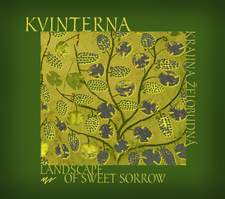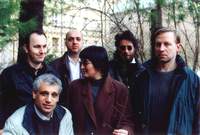ARTA classics |
|

total time - 62:46
Old Moravian and Sephardic Ballads about Love, Sorrow, Hope and Faith
- Porque llorax 6:12
- Landscape of Sweet Sorrow 4:23

- Tres hermanicas 2:42
- A la una naci yo 5:29
- Yo me levantara / Poverty 5:52
- Crab-apple Tree 1:48
- Ir me quería / Mi suegra la negra 5:52

- Mary Went to a Convent 2:26
- Nacimiendo de Moxe 4:28

- Lamentation for a Poor Woman / Consagracion de Moxe 7:31
- Nani, nani 3:53
- Hardship / Madre, la mi madre 12:03

 KVINTERNA
KVINTERNA
Hana Blochova - vocal, harp, psalterium
Pavel Polasek - vocal, cornamuses, santur, chalumeaux, gemshorns, recorders, string psaltery, duochord, chord zither, bladder pipe, hurdy gurdy, folk bass, fujara (long overtone fipple flute)
guests:
Petr Wagner - viola da gamba
Marek Spelina - flutes
Marwan Soulieman - arabian lute (oud)
Vitezslav Janda - percussion
Kvinterna Lingers in the Landscape of Sweet Sorrow
Attempts to call up from the depths of history the stories and songs that helped create the cultural identity of the Jewish community living in the Iberian Peninsula from the first century of the common era to the end of the Middle Ages are part of a general, multi-directional movement in European culture - one that aims to recover and revive our roots. Since the Jews did not write their music down in note form, we have only secondary information in the sense of written mentions of well-known singers - men and women - and the texts of songs. We shall probably never know exactly what kinds of musical transformation individual songs underwent in the course of centuries of oral transmission. This means that the way back to the forms of Sefardi music is partly the path of the scholar who delights in any objectively documented detail, however tiny, but also the pilgrimage of the adventurer, guided by inner resonances and intuition. Musicians today are equipped for the journey with a series of songbooks and collections produced by the "classic" collectors. The earliest collections are from the 19th century, but more and more are being made, often in the form of various anthologies and thematically based selections from already published collections or archival materials. Although the Sephardic songs that are still handed down (sometimes - for example in Turkey - purely aurally) and sung today are a long way from those sung by Spanish Jews at the end of the Middle Ages in terms of form and performance, they still represent a highly distinctive musical-cultural phenomenon, and in them the open-hearted pilgrim will find not just footprints of the Middle Ages, but also traces of even older cultures preserved in music from the time before the destruction of the Temple of Jerusalem. For the musical director of Kvinterna, Hana Blochova, these oriental archetypes are so potent a source on inspiration that through them she has found interconnections between Sephardic songs and Moravian folksongs. The music of the Sephardic Jews was originally modal rather than tonal and in this respect it is really closer to Moravian than to Bohemian folksong. It too has more overt pathos, but at the same time touches the emotional and mystic depths of the soul in a more immediate way.
The pieces on this recording have been taken from the collection of Sephardi songs and ballads Sefardische Liederen en Balladen (Haag 1974) and from Susil's collection of Moravian Folksongs. The songs in the Hague collection come from the archives of the Sephardi Museum in Toledo and are arranged - according to custom - into sections according to theme, occasion or purpose, with a separate section composed of songs from the period before 1492. Several songs in the collection are demonstrably of North African origin (Morocco - Yo me levantara un lunes, Consagración de Moxe), but it also contains songs from more distant areas (Bosnia - Porque llorax blanca nina, Rhodos - Tres hermanicas). For most of the Sephardic songs, however, it is no longer easy to establish the country of origin at all, especially since these songs can often be found in communities of descendants of Spanish Jews both in Morocco and Greece, and in Turkey, Bulgaria or Israel (e.g. Nani nani on this recording). The main "instrument" of Sephardic music is the human voice - Sephardic songs are part of the multi-ethnic treasury of folksongs that are sung in origin and in musical essence, and besides their direct message, offer space for the virtuosity of the performer -. The instrumental accompaniment in Sephardic music depended a great deal on the influence of the host culture. Nonetheless, for the performer living in the context of present-day, practically frontierless musical culture, it is the instrumental element in particular that offers scope for creative development and expression. Hana Blochova and Pavel Polasek - responsible for the song arrangements and the overall recording concept - have created the instrumental element in a highly individual way derived from the technique of Gothic painting. "The basic musical layer represents the subconscious - it is formed of simple, mechanically repeating structures on thrumming instruments. Out of this basis emerges another, more mobile and changeable element, which takes care of the logical and continuous interconnection of song pairs. The third layer is reserved for the melody. Finally there is a top coating - a lacqueur of further instruments that colours the whole song." (Hana Blochova) This approach also makes possible the linkage of selected songs into pairs on the basis of kinship of musical structures. Kvinterna uses some traditional Sephardi instruments, the santur and the Arab lute, the ud (al oud, the only one of the instruments used in Sephardic music in the Middle Ages to have survived - in this music - to the present day), and in Landscape of Sweet Sorrow it adds all kinds of plucked instruments whose role - apart from sound colour - is to provide the rhythmic element, since the authors of the project minimise the use of percussion with a view to the overall orientation of the content.
The musical director of the Kvinterna Ensemble, Hana Blochova studied History of Medieval Art and Restoration at Charles University and the Chemical-Technical University in Prague. Although after several years she moved from art to the musical profession, she continues to draw inspiration, correction and guidance from the world of fine art. From the beginning she specialised in medieval art and philosophy and she has brought this focus into the Kvinterne Ensemble, which she founded at the beginning of the Nineties. The performer profile of the ensemble changes from project to project, with only Hana Blochova as its fixed point, which means that Kvinterna is actually a kind of journey undertaken by its creator, with concert projects, sometimes recorded on CD, capturing stages on the road. The ensemble's first recording - Court Music of the Time of Charles IV (1997) - was directly related to Hana Blochova's research into the technology of the painting of Gothic panel pictures in the circle of Master Theodoric in the Chapel of the Holy Cross at Karlstejn Castle. The group returned to the theme of Czech Gothic music a few years later with the laconically conceived title Flos florum (2002). Hana Blochova studied singing with Marie Hrebickova-Kozakova and Inge Svandova-Koutecka, and medieval singing with Rebbeka Stewart. She sees the music of the European Middle Ages as an open space with a place for non-European, especially Oriental and Egyptian influences, and for her own creativity and improvisation. The ensemble uses copies of period musical instruments, and also ethnic instruments and different kinds of percussion, and occasionally yet other instruments (on this recording for example a thrumming instrument from the workshop of Karel Hanzik - duochord, string psaltery, psalterium, chord zither). The hidden level of the work of the ensemble is its conscious relationship to the spiritual identity of the Middle Ages - through philosophy, alchemy, rituals and so on. This line is manifest on the CD Rituals of the Middle Ages (1998) with Sibylline prophesies and Marian pilgrimage songs from Spain. To date the ensemble has taken this preoccupation furthest in the project Medieval Inspirations (2000). In the project's CD form three Sephardi songs appeared for the first time - alongside four Spanish ones - and Hana Blochova developed this interest with a later CD La rosa enflorece devoted to the music of Sephardi and Ashkenazi Jews, (2001). The ensemble performs in the Czech Republic and abroad at festivals of early and alternative music, and its appearances often have a theatrical, multimedia character. It usually records in acoustically natural spaces (The Zlata Koruna Monastery, the Gothic Church of St. Nicholas in Cecovice, the Jerusalem Synagogue in Prague). Land of Sweet Sorrow - another stage on the pilgrimage to the later European Middle Ages guided by an effort to touch its soul through music - is the ensemble's first studio recording.
Wanda Dobrovska